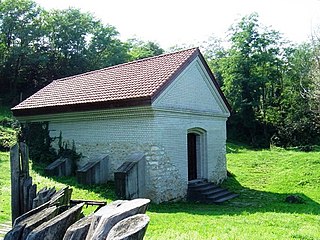Borvo or Bormo was an ancient Celtic god of healing springs worshipped in Gaul and Gallaecia. He was sometimes identified with the Graeco-Roman god Apollo, although his cult had preserved a high degree of autonomy during the Roman period.
Camulus or Camulos is a Celtic deity who was identified with Mars via interpretatio romana. Camulus was an important god of Roman Britain and Gaul, especially among the Belgae and the Remi, a Gaulish people living in the region that is now modern Grand Est around Reims.
In Gallo-Roman religion, Damona was a goddess worshipped in Gaul as the consort of Apollo Borvo and of Apollo Moritasgus.

In Celtic polytheism, Sirona was a goddess worshipped predominantly in East Central Gaul and along the Danubian limes. A healing deity, she was associated with healing springs; her attributes were snakes and eggs. She was sometimes depicted with Apollo Grannus or Apollo Borvo. She was particularly worshipped by the Treveri in the Moselle Valley.

Lugos (Gaulish) or Lugus (Latin), also known by other names, is a god of the Celtic pantheon. His name is rarely directly attested in inscriptions, but his importance can be inferred from place names and ethnonyms and status as king of the gods. His nature and attributes are deduced from the distinctive iconography of Gallo-Roman inscriptions to Mercury, who is widely believed to have been identified with him, and from the quasi-mythological narratives involving his later cognates, Welsh Lleu Llaw Gyffes and Irish Lugh Lámhfhada.
In Gallo-Roman religion, Bricta or Brixta was a Gaulish goddess who was a consort of Luxovius, god of the waters of Luxeuil-les-Bains.

In ancient Celtic religion, Maponos or Maponus is a god of youth known mainly in northern Britain but also in Gaul. In Roman Britain, he was equated with Apollo.

In Celtic mythology, Nantosuelta is the goddess of nature, the earth, fire, and fertility
In Romano-British culture and Germanic polytheism, the Alaisiagae were a quartet of Celtic and Germanic goddesses deifying victory.
Erditse is a god or goddess of the ancient Aquitaine Gaul, known by only one inscription which was discovered, in the 16th century, by Joseph Justus Scaliger on a votive altar found in the Parliament of Toulouse. The inscription was published in Inscriptiones totius orbis Romani antiquae by Jan Gruter. The votive altar has now disappeared. It was likely to come from the Pyrenees as many other votive altars found in the region of Comminges and dated from the 1st to the 4th century.
Ucuetis is a Gaulish deity who was venerated at Alesia in Burgundy.

Aignay-le-Duc is a commune in the Côte-d'Or department in the Bourgogne-Franche-Comté region of eastern France.
Acionna was a Gallo-Roman water goddess, attested in the Orléanais region.

The Fertőrákos Mithraeum is a temple to the Roman god Mithras at Fertőrákos in Hungary. The temple, follows a typical plan of a narthex followed by the shrine proper that consists of a sunken central nave with podium benches on either side.
Rudchester Mithraeum is a Roman temple to the Roman god Mithras at Rudchester (Vindobala), an auxiliary fort on Hadrian's Wall, the northern frontier of Roman Britain. The temple was located 137m to the west of the castra. It is not currently visible to visitors to the site.
Artaha is the name of an ancient goddess that was worshiped in Southern Gaul, in the region of Aquitania. She is a tutelary goddess that is thought to be associated with bears.
In Gallo-Roman religion, Sequana is the goddess of the river Seine, particularly the springs at the source of the Seine, and the Gaulish tribe the Sequani. The springs, called the Fontes Sequanae, are located in a valley in the Châtillon Plateau, to the north-west of Dijon in Burgundy, and it was here, in the 2nd or 1st century BCE, that a healing shrine was established. The sanctuary was later taken over by the Romans, who built two temples, a colonnaded precinct and other related structures centred on the spring and pool. Many dedications were made to Sequana at her temple, including a large pot inscribed with her name and filled with bronze and silver models of parts of human bodies to be cured by her. Wooden and stone images of limbs, internal organs, heads, and complete bodies were offered to her in the hope of a cure, as well as numerous coins and items of jewellery. Respiratory illnesses and eye diseases were common requests for curing. Pilgrims were frequently depicted as carrying offerings to the goddess, including money, fruit, or a favourite pet dog or bird.

Vesunna is a Celtic goddess worshipped in Roman Gaul. She was likely considered a giver of prosperity, abundance and good fortune, as evidenced by the cornucopia she is depicted carrying in her images.
The Dexivates were a small Gallic tribe dwelling in the southern part of modern Vaucluse, near the present-day village of Cadenet, during the Iron Age and the Roman period.
Rigisamus, also Rigisamos, was a deity in Gaulish and Celtic mythology who, according to the Interpretatio Romana, was connected with Mars.








